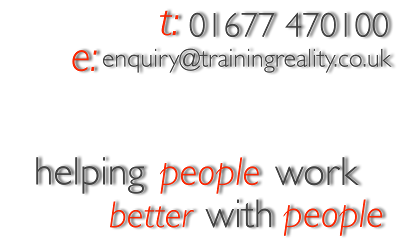Please press (at least!) one of these.
It costs you nothing, and (possibly) helps us spread the word!
Optimism, pessimism and reality - Part 3
Friday, 9 October 2009
The third, and (potentially) final part of the series on the balance, the strengths and weaknesses, and the implications of optimism versus pessimism versus reality. This article will look at the (supposed) holy grail of realism - but please feel free to review the articles and comments on the earlier entries on pessimism and optimism first.
I have been helped in this series by a chap called Dr Russ Buss, who I don’t know, but who added the first comment to that blog article. He (quite rightly) said that the definition of optimism that I’d worked with was an extreme one - blind optimism if you like - and that a type of optimism based on “effort, never giving up, looking for new ways to accomplish the goal, adjusting expectations, taking one step back to go forward” was much more helpful.
I agree, but I’d define this as “positive realism” rather than optimism. The distinction I make (and this is not about being hung up on the particular words) is along a scale like this:
Pessimism ⇒ Negative-Realism ⇒ Positive-Realism ⇒ Optimism
The middle ground is the “sweetspot” (I struggle to make that comment without thinking of the current half-butter half-not-butter advert - their marketing is having some effect on me!), whilst the extremes have some potential benefits, but often outweighed by the pitfalls.
Those of you with mathematical inclinations will realise that the sweetspot lies somewhere between positive and negative realism, and (as I’m one of those people too), that’s quite deliberate. My view is that the sweetspot, the most helpful place to be based (but not necessarily to stay) encompasses both - the ability to see the upsides and and downsides of a particular situation.
[A later blog will look into how not to let "looking at downsides negatively" affect your state]
One without the other is, in my opinion, of limited use - it would be like driving whilst never looking in any of the mirrors (I know some people seem to have this as a fundamental strategy in driving as well as life).
I also don’t think it’s about scraping around for a positive out of everything bad that happens - that can make significant things rather trivial if done to extremes. It’s more about using the breadth of the spectrum to be realistic and helpful to you in your life.
A very real, recent, and personal example. After a great weekend away last weekend, with plenty of good walks, one of my dogs started limping more significantly than she ever had before (Tess, for those of you who know them). I took her to the vets, and after some tests, we’ve found out that it’s a malignant tumor on her leg - a particularly aggressive form of cancer. Tess has been with me for over 10 years now, and I’d never want to look at some mythical “positive side” of this...as far as I’m concerned, it’s simply bad news, end of story.
Negative realism can help here though. The negative reality is that she will not last much longer, but the realism part also says that there is a lot we can do to make her time as comfortable as possible, keep her happy, and ensure we make the most of the remaining time with a wonderful dog. I’m being realistic.
--
In summary, there are three things that I’ve taken out of this thought process to learn from, and some of them may well help you too:
1) Being aware of where your natural behavioural tendency lies along the scale can really help the development of your self knowledge. Doing this in isolation might be a little tricky (the scale, after all, is a relative concept), therefore it’s helpful to be comparative with people you know, and perhaps discuss it with people who know you well and are prepared to be very honest with you.
2) I’m uncomfortable picking a spot on the scale and saying “that’s where I am, that’s me”. Being able to dip in and out of the alternative perspectives on a situation can help enormously with bringing it to life, adding new interpretations, and deepening your understanding.
3) Once you’ve become aware of your natural instinct, and practiced dipping in and out of the various perspectives, you will have a much greater ability to choose the position on the scale that is most helpful and most appropriate to any specific situation, be aware of the potential negative consequences of that view, and make smarter decisions and actions.
Please press (at least!) one of these.
It costs you nothing, and (possibly) helps us spread the word!





